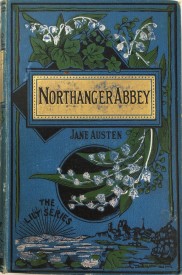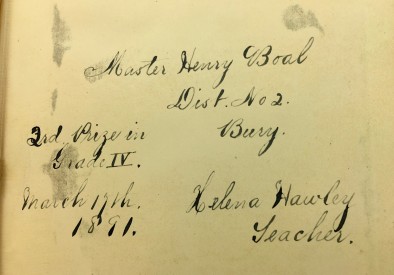It is an honor to share with you some of the unsung copies of Northanger Abbey that came to light during my research for The Lost Books of Jane Austen. This project, which began as a local curiosity, grew into a decade of unconventional book hunting. The central idea behind the project, however, has remained steady and simple: cheap books make good authors canonical. Cheap books spread fame but they also tend to be consumed rather than collected. And there’s the rub. Cheap reprints of Jane Austen are “the lost books.” Frustratingly few examples survive of what may be the best markers of her reception history.
Before turning to the technology of stereotyping that helped lower the cost of books during the nineteenth century, allow me to show you a smattering of Austen’s cheapest, most badly printed, least authoritative, and most neglected editions. I had a lot of necessary help from private collectors who have safeguarded the fragile survivors of these under-appreciated reprintings for posterity. I warn you, this slideshow is not pretty, for cheap books live hard lives.1
In the latter half of the nineteenth century, cheap and shoddy versions of Jane Austen’s novels performed the heavy lifting of bringing her work and reputation before the general public. Inexpensive reprints and early paperbacks of Austen were sold at Victorian railway stations for one or two shillings, traded for soap wrappers, squeezed into tight columns on flimsy paper for mere pennies, awarded as book prizes in schools, and targeted to the working classes. Few of these hard-lived books survive. Yet scrappy versions of Austen’s novels made a substantial difference to her early readership. These were the books bought and read by ordinary people. And these are the books that, due to their low status and low production values, remain largely absent from the shelves of academic libraries and thus unremarked by scholars.
In Britain, the waste paper drives of both World Wars ensured that many cheap editions deemed unimportant were simply pulped. In America, ill-placed concerns about acidic paper resulted in nineteenth-century books being tossed by librarians favoring storage on microfilm. My research challenges traditional valuations of what constitutes an “important” version of a book in an effort to democratize Jane Austen’s reception history and consider how books read by working class readers, non-scholars, and schoolchildren impact literary reputation. My interest lies not in abridgements or adaptations, but in lowly versions of the novels in their entire—uncut and unfiltered. Even when the words inside books are identical and the stories complete, shoddy versions present Austen’s fame differently than do precious editions painstakingly safeguarded by scholarly libraries and traditional collectors. Only lowbrow versions of Austen’s novels can show scholars and fans alike that her burgeoning literary reputation was not the tidy accretion of polish, status, and starch that history has inadvertently made it out to be. Original, authoritative, and handsomely illustrated editions did help Austen’s early visibility, to be sure, but so did the numerous unsung reprintings at the bottom end of the book market—and in messy and startling ways. By literally cheapening Austen, these versions showed an everyday writer whose public appeal differed radically from the official canonical author proffered and supported by those fine editions.
The orthodox view and Richard Bentley
It is well known that Jane Austen’s reputation lay dormant for the fifteen years or so following her death in 1817. The orthodox view is that she reached a wide English audience only after Richard Bentley (1794–1871) revived her work for his “Standard Novels” reprint series in 1833. But Bentley, although he was an important catalyst, is not the true hero of our Sleeping Beauty story.
His books were also not as cheap and accessible as scholars, taking Bentley’s advertisements at their word, have assumed. Bentley emphasized the inexpensive nature of his handsomely produced, compact volumes, ornamented with elegant frontispieces and title page illustrations: “price 6s.” and “Cheap Edition.”2 He was an early adopter of publisher-issued bindings in cloth and his prices not only reflected the paper savings of his three-in-one-volume format but the sudden freedom from traditional leather bindings. Scholars have amply recorded and praised Bentley’s reprintings of Austen as “Standard Novels,” stressing their authority (after all, only he paid for proper copyrights) and stressing their importance as Austen’s reputational turnkey.3 Bentley, it is said, unlocked her fame. As a result of this attention, Bentley’s sedate volumes are now highly sought after. However, Bentley’s influence upon Austen’s reception may be greatly overplayed, for his books were quickly joined by far cheaper versions with a much wider impact. The role of these less-princely reprints has been largely ignored in the dominant fairy-tale version of Austen’s reception.
My research focus is therefore not on Bentley’s well-touted books but on the neglected products of his downmarket competitors. Bentley’s prices and claims to cheapness, however, do help to calibrate all that came next. So, let’s recap the facts and numbers. In 1811, the first edition of Sense and Sensibility had sold in three volumes for fifteen shillings in boards—as a proper binding remained extra. In December 1815, advertisements for the first edition of Emma raised that price by six shillings to a guinea, or twenty-one shillings, for its three volumes in boards.4 The four-volume set of Northanger Abbey with Persuasion sold initially for twenty-four shillings, which was a further three-shilling top-up. In other words, handpress books in Austen’s lifetime remained luxury items, which explains why her novels appeared in such modest runs—possibly as low as 750 copies of Sense and Sensibility and as high as 2000 copies of Emma.5 Then, in 1833, Bentley introduced his well-made reprints of Miss Austen in single volumes at six shillings each in durable publisher’s bindings of plum-colored linen with paper labels.6 Bentley’s runs were large for the time (around 4000 per title), and his six-shilling price tag comparatively low. By means of stereotyping, as I shall explain, Bentley periodically continued to reissue identical Austen volumes through 1866, briefly lowering his price still further in the 1840s in response to pressure from competitors. Meanwhile, the cost for an upmarket first edition of a new novel in the three-decker format made popular by Sir Walter Scott stubbornly held until the mid 1890s at £1.11s.6d. (or 31.5 shillings).7 No wonder then that scholars, comparing Bentley’s prices to those for first editions, have hailed him as Jane Austen’s reputational Prince Charming.
Bentley’s relative bargains and large print runs certainly pushed Austen’s visibility, but his six-shilling reprints were still not within easy reach for a skilled worker earning twenty-five shillings per week, let alone an unskilled laborer earning half that wage.8 In the 1830s, bookselling remained, in the words of publisher George Routledge, “a peculiarly rotten system of providing only for the select few” (“Cheap Books”). Bentley’s much-hailed “cheap” books were the purview of well-to-do Victorian clients such as socialite Lady Molesworth of Pencarrow, close friend of Thackeray and Dickens, who owned a complete set of Bentley’s reprints of Austen published in 1856, that she had bound in green cloth prettily stamped with a gilt design.9
In 1846, after the copyright of Austen’s first three novels expired and competition by upstart publishers increased, the fastidious Bentley was briefly forced to drop his price to 2s.6d. per volume, adjusted in 1848 up to 3s.6d.—slumming it in order to place his Standard Novels, ostensibly, “within the reach of all classes of readers.”10 Surviving Bentley copies of Austen from this period are extremely rare, but those in their original publisher’s bindings bear witness on their spines to his momentary drop in price, itself a fraught response to the radical changes in the marketplace wrought by cheaper fare.
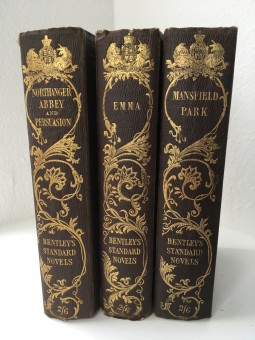 Copies dated 1846 of Austen’s novels in the Standard Novels series published by Richard Bentley. Original publisher’s binding, with price “2/6” on spines. |
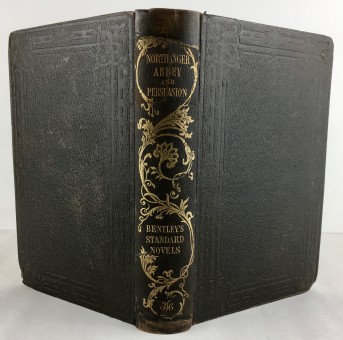 Copy dated 1848 of Northanger Abbey/Persuasion in the Standard Novels series published by Richard Bentley. Original publisher’s binding, marked “3/6.” |
By 1870, however, Bentley had abandoned the battle for the cheaps to others, having sold at auction his plates for all his Standard Novels only to climb safely back to his preferred six-shilling rung with a reset and enlarged authorized edition. By then, far cheaper versions of Austen in astonishingly large numbers and unprecedented variety were newly reaching working-class audiences. Publishers such as Simms & M’Intyre, Routledge, and Chapman & Hall were then selling their forerunners of airport paperbacks out of railway stations and bookstalls for a mere one or two shillings, with some as low as sixpence. Fluctuating production values, including paper quality, meant that not all of these other nineteenth-century versions aged well. Few ended up in libraries. And yet these reprints, dismissed as dubious by all but the occasional antiquarian in favor of the sturdier stuff of authoritative firsts or scholarly editions, nevertheless enabled Austen’s global celebrity.
Stereotype technology and duplication
Over the course of the nineteenth century, books became drastically cheaper due to a number of innovations: machine-made pulp paper, new distribution channels enabled by a national rail system, and stereotype technology all lowered production costs. But it is the technology of stereotyping that complicates the valuation and taxonomy that lie at the heart of bibliography. David Gilson’s A Bibliography of Jane Austen remains the definitive inventory consulted by libraries and collectors. Ironically, precisely due to Gilson’s rigorous bibliographical training, which taught him to ignore externals such as binding styles, his list of editions proves far from comprehensive. Both book technology and taxonomy, therefore, warrant brief explanation in order to understand why so many reprintings of a major author have gone unrecorded even by her finest bibliographers.
Many nineteenth-century books claim to be new editions when they are actually pre-existing books dressed in the frocks of updated title pages and fresh paper wrappers or binding styles in cloth, known as casings. Setting a book anew from loose type was time-consuming, cost a great deal, and took up much of a printer’s type stock for the production of a single work. But stereotyping, a technology fully adopted by the 1840s (Bentley was an early adopter), enabled cheap books to flourish by allowing printers to mold and then cast in metal the labor-intensive multi-page formes of set type. Publishers could then reorder, from these flat plates, the same printed text at intervals, whenever existing stock became depleted.11 Individual print runs could be reduced to several hundred copies instead of thousands, further lowering both the risk of over-exposure and the cost of inventory storage for publishers. True, over time, the stereotype plates wore down, lessening the sharpness of the type in later impressions, but printers nonetheless hailed these slabs of metal for their longevity and capacity to retain their value over decades—if carefully stored and handled. Whenever a publishing firm thought its own market for a title exhausted, or liquidated assets for other reasons, it could sell such plates to another publisher via a private sale or public trade auction. Swaps and sales of plates happened on both sides of the Atlantic. Publishers of cheap books worked stereotype plates to their limits, enthusiastically reprinting and repackaging the same text year after year to make old books look perpetually new.
Bibliographies prominently list editions. The key to bibliographical taxonomy turns upon the central text, which in this assortment of eight books, starting with a Bentley copy of Northanger Abbey/Persuasion on the top left, is identical because they are all printed from the same stereotype plates, even if by different publishers—with the same words, layout, and page numbers.
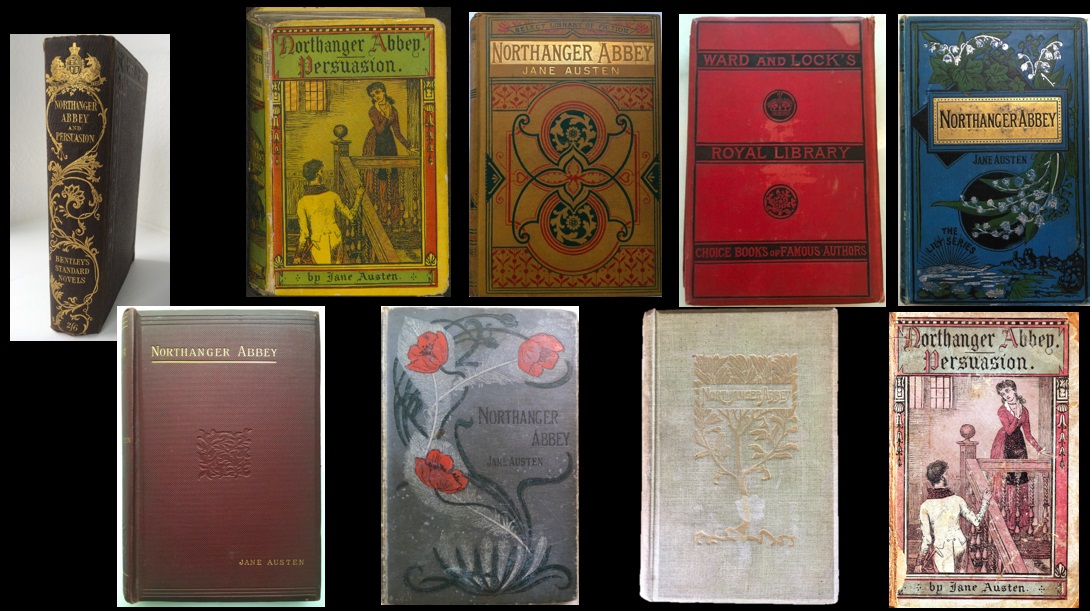
Nine copies of Northanger Abbey/Persuasion printed from the same set of stereotype plates. The plates were originally commissioned by Richard Bentley in 1833 and remained in active use by others through to about 1900. Collections of Sandra Clark and Janine Barchas. (Click here to see a larger version.)
The taxonomic category of an edition becomes, in the age of stereotyping, slippery: “Strictly speaking, an edition comprises all copies of a book printed at any time or times from one setting-up of type without substantial change.”12 An impression refers to a printing or reprint run of an edition made in one go, without the type being removed from the press. These professional bibliographical terms were constructed with an eye to hand-press books made during the nearly four centuries between Gutenberg in the 1450s and stereotype technology by the 1830s. With stereotyping, how much time between print runs from the same plates (even if under the direction of the same publisher) is enough to warrant a separate bibliographical entry? Gilson, who records some additional runs and series as “reissues” but not all, shows that bibliographical assessment of nineteenth-century books becomes a judgment call about their importance. More than semantics is at stake here, for the cheap volumes that get left out of formal inventories reveal Austen’s active participation at the neglected bottom-end of the book market, even as they muddy bibliographical waters.
The eight non-Bentley copies tracked in the following slides, while bibliographically identical on the inside when it comes to the central text of the two-in-one stories, differ in look, price, and virtue signaling—the features that determine audience. Most copies are undated. As you view the slides, I want to convince you that each iteration of ostensibly the same book offers may offer slightly different information in the history of Austen’s reception.
Articles differ from public talks, and if you are reading my words and clicking through the slides on your own, you will see evidence for the following trade phenomenon, which I provide below as a bulleted list but narrated off-script in my plenary talk. Although I selected the Northanger Abbey examples uniquely for the Williamsburg AGM, my book The Lost Books of Jane Austen provides more information (and many other examples) about the proliferation of cheap Austen copies in the latter half of the nineteenth century, which occasionally involved internal duplication from shared or sold stereotype plates.
- The timeline of these books begins with Bentley, who prints Northanger Abbey/Persuasion from his self-made plates from 1833 to 1866, producing for more than three decades elegant one-volume books packaged with his tell-tale engraved frontispieces and title-page vignettes. Bentley sold his Austen plates by 1870, the year he advertises an enlarged and reset Austen edition at his preferred middle-class, six-shilling price point—abandoning the increasingly chaotic lowbrow trade to others.
- For the next decade, lowbrow publisher Chapman & Hall squeezes more life out of Bentley’s well-used plates, printing Austen’s six novels in various formats, including a two-shilling “yellowback” of Northanger Abbey/Persuasion. Yellowbacks were a popular genre sold at railway stations in illustrated paper boards that, by the 1870s, resembled the art on penny dreadfuls and resulting in tawdry lowbrow Janes. Notice how in 1872, the Chapman & Hall reprint has the gumption to call itself a “NEW EDITION” on the title page, even though it is printed from Bentley’s old plates that are then nearly forty years old.
- In the 1880s and 1890s, different iterations of the publishing house Ward & Lock (which changes its name slightly over the years in response to different partnerships) print numerous “editions” of Austen in stiff boards and variously decorated cloth covers—making Austen part of a dizzying array of cheap reward series as well as the fare of bookstalls at train stations. False claims of newness resurface here and there. When copies remain strategically undated, evidence from accompanying advertisements, bound publisher’s lists, and ownership marks help sort. The slides demonstrate visible evidence of plate wear, for these hard-working books, re-packaged in attractive ways on the outside, increasingly showed their age on the inside. Caveat emptor!
- Circa 1890–1891, the Grand Colosseum Warehouse sedately repackaged many of the Ward & Lock titles, including Austen, for a Colonial market.
- All in all, this string of copies proves that the same plates remained in use from 1833 to circa 1900—a staggering seven decades of mercurial repackaging despite internal stability. Naturally, not all cheap nineteenth-century reprintings derived from Bentley’s old plates. There were other independent reprintings that competed simultaneously with these consecutive reprintings from the Bentley plates. But placed side by side, the genetics of this family of survivors explains why bibliographers (concerned primarily with the inner text) ignore many minor reprintings as duplicates of earlier editions that do not require individual attention. Hopefully, these copies also demonstrate why reception history should, instead, acknowledge such differences among Austen’s proliferation.
Celebrity copies
Admittedly, not all insignificant reprintings have been tossed or ignored by elite libraries. Since everyone likes a bargain, some of Austen’s most important critics and fellow writers encountered her in workmanlike copies. Celebrity provenance has been the exception to standard collecting practices, allowing a few ordinary copies of Austen to be made extraordinary by the people who owned them. For example, an unassuming late-Victorian reprint of Northanger Abbey once belonged to Samuel Clemens and is now a well-guarded treasure at The Mark Twain Library in Redding, Connecticut.13
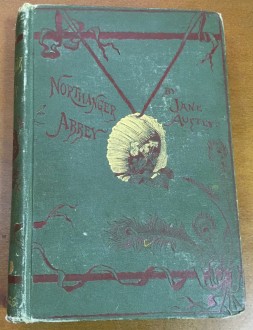 |
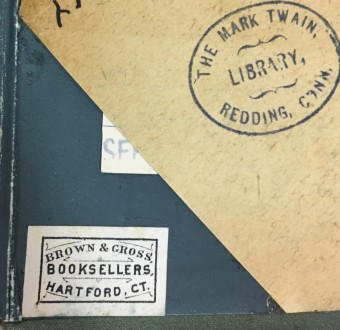 |
|
| Twain’s copy of Northanger Abbey/Persuasion, a reprint by George Routledge circa 1890 from plates first used in 1883. Courtesy of the Mark Twain Library, Redding, CT. (Click here to see a larger version of the left image.) | ||
(I paused here for possible hissing, since Janeites know that Mark Twain was no fan.) Printed by Routledge in the late 1890s from plates birthed in 1883, this copy of Northanger Abbey is saved for Twain’s celebrity and not Austen’s.
Similarly, the Harry Ransom Center in Austin, Texas, safeguards this unassuming 1897 copy of Northanger Abbey/Persuasion because it once belonged to the library of author H. G. Wells (1866-1946).14 Wells inscribed the book to his wife, Amy Catherine Wells (1872–1927), in the style of a mock school prize. The inscription, ornamented by him with a wee crown, awards the book somewhat condescendingly to “A. C. Wells / Feb. 21, 1899” as a “Prize for Good Conduct.”
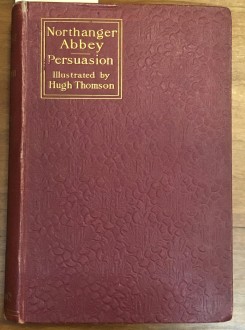 |
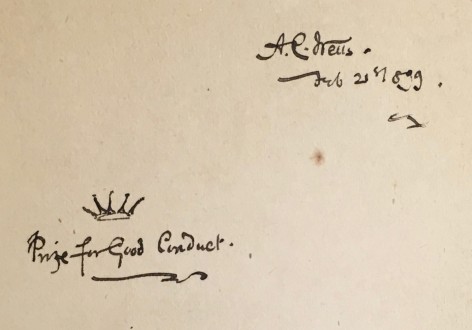 |
|
| Northanger Abbey/Persuasion (London: Macmillan and Co, Limited, 1897), illustrated by Hugh Thomson with an introduction by Austin Dobson. Gift inscription from H. G. Wells to his wife, in the style of a mock school prize. From the library of H. G. Wells. Harry Ransom Center, Austin, TX. | ||
Another unlikely resident at the Harry Ransom Center is this stained and shabby Everyman’s Library copy of Northanger Abbey/Persuasion, which was owned by author T. H. White (1906–1964).15 Six years before publishing The Sword in the Stone (1938), White wrote a locked-room mystery called Darkness at Pemberley (1932) in which murder menaces the descendants of Darcy and Elizabeth. Notes inside this water-stained copy of Austen (the Ransom Center would want me to make clear that it arrived in this condition direct from White’s residence) prove how White was attentive to the works that she, in her turn, referenced in Northanger Abbey.
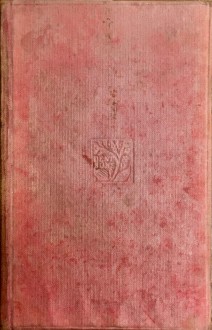 |
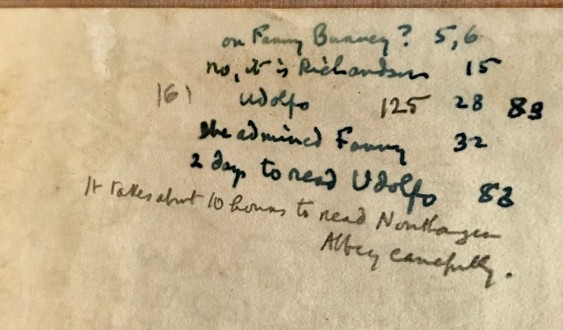 |
|
| Northanger Abbey/Persuasion, with introduction by R. Brimsley Johnson (Dent & Dutton, 1919). Annotations by T. H. White on the paste-down at the back of his copy. From the library of T. H. White. Harry Ransom Center, Austin, TX. | ||
Such commonplace versions of Austen are preserved because they offer clues to how other famous writers read and worked. But what of the ordinary copies read by the so-called common reader? What might they tell us about who read Austen and in what context?
Ordinary copies and their readers
Throughout my research, I was gobsmacked not just by the unexpected range and number of Austen novels offered at low price points that had never been recorded by bibliographers but by the information they still yielded about reading habits. Why do we not shout off the rooftops how Austen was offered for sale at sixpence to the working classes in the 1850s and rendered into half-penny installments in the 1880s, or celebrate that her work was selected as a book prize for hard-working coal miners in the 1890s?16 Are historians and libraries embarrassed by lowly versions of great books? Surely Austen’s reputation is now robust enough to withstand the radical idea that she might have been popular before she was judged as great by the learned. Slowly, I have come to love the cheap, crappy, ill-made books that did the hard work of building Austen’s fame from the ground up.
I freely admit, however, that my learning curve on this project has been steep and inelegant. Schooled in the bibliography of handpress books of the eighteenth century, some of my own first impressions of Victorian reprints proved, well, dead wrong. In the beginning of this project I guessed wrong about price points, about dates of publication, about aesthetics, and about audience—often because it was so hard to shed my own anachronism and not judge the covers of old books with either a modern eye or a bibliographer’s rigid categories. Some colorful specimens of publisher’s bindings, which I had thought rather fancy at first glance, proved among the schlockiest and most ill-made examples of clothbound books on the market.
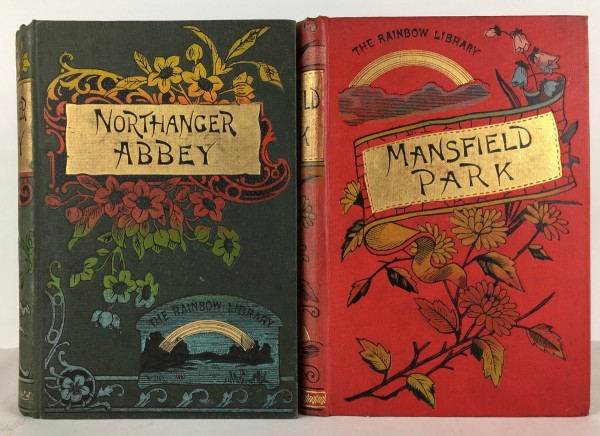
Undated copies of Northanger Abbey and Mansfield Park in the Rainbow Library series, published circa 1900 by Richard Edward King, printed from old stereotype plates on cheap pulp paper and bound in colorful cloth casings for the school prize market. Collections of Sandra Clark and Janine Barchas.
Decorated with splashy colors and bling to appeal to the magpie eyes of youth, such books were printed circa 1900 by Richard Edward King, a true bottom dweller of London’s publishing industry—about whom history therefore remembers practically nothing. Printed on low-quality paper, using tired and worn-down stereotype plates that had already served many prior masters, these glitzy-but-cheap books (I now think of them as fodder for a possible Pimp My Book demo) were aimed at the school prize market in Britain. For the working-class children who received them, these books were surely wondrous trophies. But as they are neither authoritative nor well-made, these “editions” failed to gain regular access to libraries or the bibliographical record.
I was surprised by how many lowly clothbound books were inscribed with names of prior owners. Information derived from these names challenged my sense of Austen’s nineteenth-century reader—that nameless generic ghost so often invoked by scholars like myself. The names altered my assumptions of Austen’s history of gendered marketing and the ages of her presumed readers. In 1891, it was “Master Henry Boal” who won this inexpensive Lily Series copy of Austen’s Northanger Abbey/Persuasion bound in blue cloth with silver stamping.
| Northanger Abbey/Persuasion in the inexpensive Lily Series (London and New York: Ward, Lock, and Co., n.d., c. 1890), awarded as a school prize. Author collection. | ||
The Victorian “language of flowers” assigned symbolic significance to different flower species, with the lily holding a special place in Christian iconography and signaling purity. In other words, many floral designs were initially perceived (by the parents and teachers who gave out these books) as gender neutral—as testified to by surviving copies inscribed with the names of their real teen readers, boys as well as girls ages twelve to fourteen.
As I traced the names of real readers to census records, sometimes by means of a mere few clicks via Ancestry.com, I slowly discovered that prize books, too, had a dark side. Research proved that many such names belonged to young working-class readers whose gritty circumstances combined uneasily with the elegant Regency world of Austen’s stories or the bright and sunny covers of these books. About 1910, Blackie & Sons of Glasgow published Northanger Abbey in a popular gift series that joined her to dozens of juvenile titles bound in similar cloth casings of popping bright colors, each stamped with the same eye-catching Mackintosh Rose design that is the hallmark of Scottish art nouveaux.
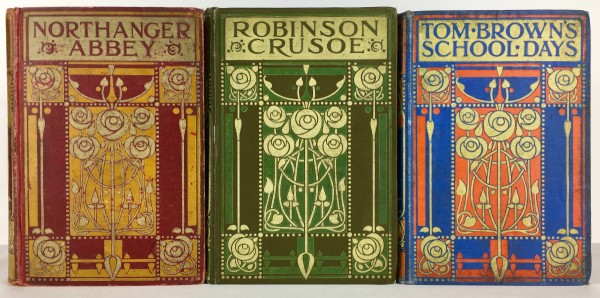
Copies of Northanger Abbey, Robinson Crusoe, and Tom Brown’s School Days in Blackie’s Crown Library Series, a popular juvenile award series in the 1910s. Author collection.
In this series, once popular as school prizes but not as collection material for serious libraries, Austen kept company with Dog Crusoe, Hans Brinker, Swiss Family Robinson, Little Women, and The Wide, Wide World. Printed from hand-me-down plates (although not Bentley’s), the central text of these juveniles was internally identical to other Blackie versions, ranging widely in production values. Blackie recycled its stereotype plates for decades.
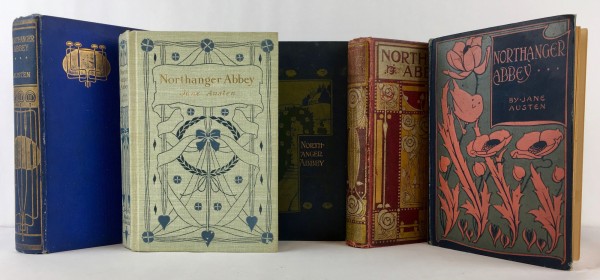
Published by Blackie & Son of Glasgow, these five undated reprints of Northanger Abbey were printed using the same plates. Between roughly 1895 and 1915, Blackie & Son offered these identical reprints of Northanger Abbey at varying price points in a range of series. Author collection.
(Click here to see a larger version.)
A bookplate in one copy identifies it as a school attendance prize for 1910–1911, sanctioned by the Burgh School Board in Forfar, Scotland.
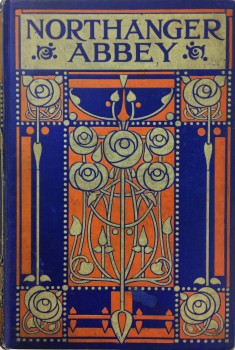 |
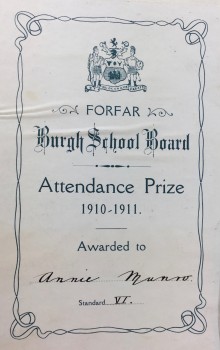 |
|
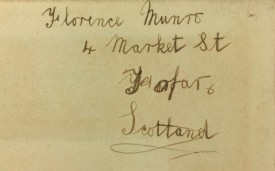 |
||
| Annie Munro’s copy of Northanger Abbey (Glasgow: Blackie & Sons, n.d.). Author collection. | ||
A century ago, the book would have been even brighter than it remains today and must have made a stunning prize for the Annie Munro named as proud recipient. The name of another girl, presumably her sister, is written opposite, in a childish hand on the top of the free endpaper:
Florence Munro
4 Market Street
Feofar
Scotland
Even after an awkward self-correction, the town remains slightly misspelled.
In spite of the misspelling, the specific street address and two full names made finding the Munros at 4 Market Street easy. According to the 1911 census, the Munro family consisted of two working-class parents in their early forties, Bain and Annie Munro, plus their six daughters, ranging in ages from nineteen to two.17 Bain Munro, age 42, worked as “mechanical engineer” in an “Iron Foundry.” The eldest daughter, Norah (19), was a weaver of linen and jute, while Florence (16) is listed as “dressmaker.” In other words, the older Munro girls were already wage earners. Annie (12) remained in school, along with Helen (7). The littlest Munros, Alice (4) and Jessie (2), remained at home with their mum.
The handwritten inscription looks more childish than that of a sixteen-year-old. Annie, four years younger than Florence, seems the likeliest person to have made her own prize over to an older sister. As someone personally familiar with the complexities of barter economics among siblings, I first hazarded that Annie, perhaps with great ceremony, traded her fancy school prize with her sister in exchange for a book she preferred to Austen. Or, I thought, perhaps Annie was, to paraphrase Elizabeth Bennet, not a great reader and had pleasure in other things? Northanger Abbey, with a seventeen-year-old heroine, does seem more apt reading for sixteen-year-old Florence than twelve-year-old Annie. But my guesses were innocent of Annie’s true circumstances.
Sadly, on December 5, 1911, less than six months after receiving this book, Annie died of diphtheria and toxemia in the local hospital—at the age of thirteen.18 Perhaps Annie valued her shiny, bright, prize book so much that she gave it to her sister Florence just before her death, solemnly bequeathing it with that shaky inscription. Annie’s colorful prize book may have been brought to her in hospital for reading aloud or as a comfort. Only ten days later, on December 15, little Alice Munro, aged five, also succumbed to diphtheria.19 The deaths of the two Munro girls were part of a wider diphtheria outbreak, for the entry prior to Alice’s mentions an eight-year-old boy dying of the same disease four days earlier. Effective world-wide vaccination against this disease did not begin until the 1920s. Among the overcrowded homes of the Scottish working classes just before World War I, many such outbreaks ravaged not just families but whole towns. In the wake of such tragedy, many of Scotland’s working poor made their way to countries such as the United States and Australia.
Eventually, Florence also went to America, and in 1915 an outward-bound passenger list gives her occupation as “dressmaker.”20 The highest level of education reported for Florence Munro (1894/5–1946) on her immigration papers to the United States was that she completed “elementary.” Florence married Michael Mowers (1893–1968), a carpenter in road construction from New York, and they had two daughters. As a naturalized American citizen, Florence was buried in Madison County, New York. Leaving school by fifteen did not prevent her from building a productive life. In the context of these working-class patterns of girlhood, book prizes had a different currency than the perfunctory role they often serve today. At a time when girls turned wage-earning women at fourteen or fifteen, a book of one’s own was not, as now, a passport to further study, but often the end of childhood and book learning. In Annie’s case, this copy of Northanger Abbey may have been, quite literally and brutally, her very last book. For me the book was a reality check, telling the unvarnished story of real readers of Jane Austen. This research was no longer “academic.”
On a lighter note, cheap books challenged my ideas of good taste.
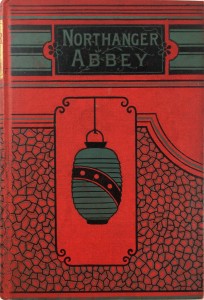 |
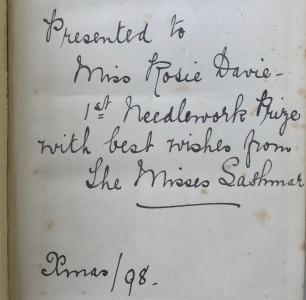 |
|
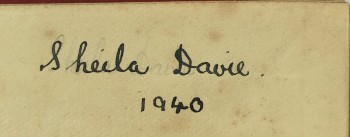 |
||
| Cheap reprint of Northanger Abbey/Persuasion (London: George Routledge and Sons, n.d.) published in 1880s, awarded to Rosie Davie in 1898, and with further ownership signature of Sheila Davie dated 1940. Collection of Sandra Clark. | ||
Then as now, some marketing gimmicks or packaging proved bizarre, even when, on the inside, the careful transfer of property from one relative to another suggested that the book had been treasured across generations. The late-Victorian fashion for dressing English classics in a European interpretation of Asian costume was surprisingly widespread although, thankfully, of short duration.
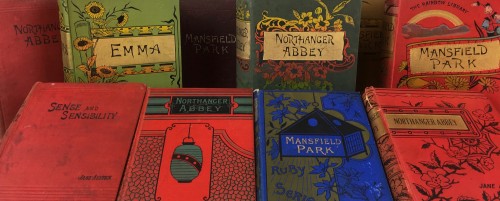
Cheap Jane Austen editions, printed roughly between 1880 and 1900, packaged in so-called chinoiserie designs. Collections of Sandra Clark and Janine Barchas.
(Click here to see a larger version.)
The so-called chinoiserie designs for Jane Austen from the 1880s and 1890s make for a strange assortment of books. Only popular mass-produced reprints can demonstrate how ordinary readers encountered Austen’s literary works. The extraordinary ordinariness of these books is what makes them such credible witnesses to the history of reading.
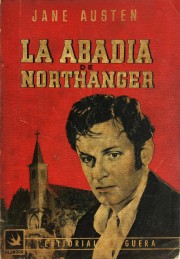
Spanish paperback of La abadia de Northanger (Barcelona: Bruguera, 1945). Original price 6 pesetas. Author collection.
Even twentieth-century packaging requires local knowledge or historical context to appreciate. In the 1940s, Hollywood movies became book cover fodder for continental translations. Many early paperbacks of Austen sold in Europe appropriate movie stills that, today, seem haphazard at best. This Spanish copy, published in Barcelona in 1945, offers Olivier-turned-Heathcliff in the film Wuthering Heights (1939) as the face of Northanger Abbey.
The cover image is a conscious marketing tactic rather than a naïve gaffe. In 1940, Laurence Olivier had played Mr. Darcy opposite Greer Garson in Pride and Prejudice, ghosting Austen’s proud hero with memories of Brontë’s brooding creature from the year before. With no equivalent movie of Northanger to pilfer for stills, the Spanish pulp publisher neatly manages to invoke this novel’s gothic elements by eliding Austen and Brontë with a celebrity photo of Olivier. This is about selling translations of old books with Hollywood glamour in war-torn Europe. Then as now, marketing does not demand interpretive accuracy or a perfect match between celebrity and product.
Some continental translations of Austen look comparatively understated, but even quiet designs can bear witness to local reading habits. Take these unassuming post-war French translations of Northanger Abbey, published under the title Catherine Morland.
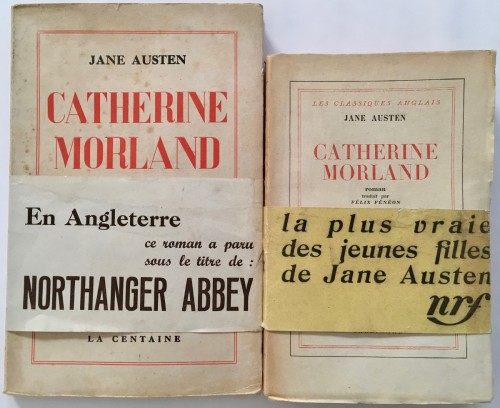
Post-war paperbacks of Catherine Morland, the French translation of Northanger Abbey The copy on the left was published in Brussels in 1945; on the right is a Parisian reprint dated 1946, part of a series put out by the literary magazine La Nouvelle Revue Française, (hence the initials “nrf” on the protective paper cuff). Author collection.
The copy on the left appeared in Brussels in 1945, and the smaller one on the right in 1946 in Paris.21 The comparative austerity of these copies reflects dominant local print aesthetics as well as war-era scarcities. Both copies reprint the 1899 translation by Félix Fénéon (1861–1944), a famous Parisian anarchist and art critic, whose translation disappointed his contemporaries, with one reviewer describing it as “singular, almost disconcerting.”22 Fénéon nonetheless continued to lend political frisson to Austen, whose novel he had translated while in jail for blowing up a restaurant.
At a time when cheap reprints of even old books were coveted commodities across war-ravaged Europe, fragile paperbacks printed on poor-quality paper were wrapped carefully in tight paper bands, like cuffs, that encircled the books to prevent eager thumbs from despoiling them before purchase. These protective cuffs doubled as additional advertisement space. The Belgian band straightforwardly offers the original English title while the French one insists on Catherine Morland as the most compelling young heroine in all of Austen: “la plus vraie des jeunes filles de Jane Austen.” That tagline allows, in the manner of all ad copy or banner headlines, a local play on words. The phrase vraie jeune fille idiomatically refers to a maiden—to the sexually uninitiated. Asserting on its face that young Catherine Morland is the most true of Austen’s young heroines, the emphatic “plus” perhaps protests too much. In other words, this seemingly unassuming copy of Austen, when displayed in the book and magazine stalls of war-torn Paris, intended to titillate passersby with the cheeky promise of a daring coming of age story. With the band removed at purchase, the cheap book would regain its safe, po-faced composure as a serious classic. Original book bands rarely survive because these were meant to be detached at the time of sale, so advertising copy, too, is often lost.
To be sure, these books are not authoritative editions of Jane Austen. These French and Spanish versions are not important scholarly translations of her work. And the readers to whom all these books aspired were not high status. But that is precisely the point. While Austen’s literary brand may be global now, the hard work of building her elite reputation was achieved in the trenches of lowbrow print culture—with books that engaged local constituencies in unique ways. Throwaway reads helped make Austen’s reputation robust.
NOTES
1Only a selection of the slides shown during this talk could be reproduced in this article, although many more images are included in The Lost Books. Any overlap between this article and that book is reproduced with permission.
2Advertisements in The Morning Chronicle (1 Feb. 1833) and The Examiner (24 Feb. 1833).
3Bentley purchased from Thomas Egerton and the Austen family the copyrights to Pride and Prejudice, Sense and Sensibility, and Mansfield Park for twenty-eight years from initial publication, plus the copyrights to Emma and Northanger Abbey/Persuasion for forty-two years. His access to the first three novels expired in 1839, 1841, and 1842, respectively, while his hold over the last three novels lapsed in 1857 and 1860. These expiry dates explain why Bentley’s competitors pounced on reprinting some novels earlier than others, although, as I will show, not all publishers waited politely for copyrights to terminate, cutting short Bentley’s presumed exclusivity. See Gilson, A Bibliography (211). Gilson assigns “Editions Published by Richard Bentley” their own substantial section in his bibliography, complete with illustrations in the 1982 edition (211–34).
4Only when John Murray remaindered unsold copies did the price of Austen’s novels drop, briefly, to 2s.6d. In January 1821, Murray remaindered a substantial number of copies after interest at the standard price stalled: 498 copies of the second edition of Mansfield Part at 2s.6d.; 529 copies of Emma at 2s.; 282 copies of Northanger Abbey and Persuasion at 3s.1d. See Gilson, “Jane Austen’s Text” (66).
5For estimated first-edition runs, see Gilson (8, 69).
6On October 26, 1833, the Athenaeum advertised all six Austen novels as a “set” in five volumes for 30s., “elegantly printed and embellished, neatly bound for the library.” Northanger Abbey and Persuasion shared a volume. For a description of the four distinct binding styles, see Sadlier (2:96). Optional leather bindings sold at a higher price.
7The first novel sold at this price was Sir Walter Scott’s Kenilworth in 1821. See Eliot and Nash (419).
8According to Porter, workers in London received these wages for a ten-hour day and six-day week during the mid-1860s: common laborers 3s.9d.; bricklayers, carpenters, masons, smiths 6s.6d.; engineers 7s.6d. Other sources estimate higher weekly wages, with clerks earning 10s., laborers 20s., and artisans up to 36s.
9Lady Molesworth’s signed set is in the collection of Sandra Clark. Bentley’s top-end middle-class prices resemble those of George Mudie (1818–1890), famous as the founder of high-end Victorian lending and subscription libraries where readers could also purchase a selection of books in handsome bindings. In 1878, Mudie’s Barton Arcade branch in Manchester advertised all of Austen’s novels for purchase in ornamental bindings of “Half Morocco” for 6s.7d. each, suitable as “birthday presents and bridal gifts” (British Library, RB.23.a.21392[6]). The British Library’s website, when displaying a few of Mudie’s catalog pages, glosses 6s.7d. as “equivalent to a week’s rent on a three-bedroomed terraced townhouse.”
10See Gilson (227). He records seeing copies in original bindings with prices stamped on the spines “2/6” and “3/6” dated 1846 and 1851, respectively, to which I can add a similar copy of Northanger Abbey/Persuasion dated 1848 (already marked “3/6”), with advertisements on the endpapers listing all his Standard Novels and Romances for 3s.6d., including Austen (qtd. from internal advertisement on endpapers of that 1848 copy).
11“The real power and value of stereotyping, which had been widely regarded with such suspicion in the 1810s and 1820s, was proved when stereotypes and the harder electrotypes were worked to their limits in order to meet demands from a reading public used to the idea of cheap books” (McKitterick 86). For a description of the technology and its influence in America, see Winship. American professional habits and storage practices differed from British ones, but stereotyping lowered book prices on both sides of the Atlantic.
12See definition of “Edition,” in Carter and Barker.
13The edition at the Mark Twain Library of Northanger Abbey is undated, with an imprint “London, Glasgow, Manchester, and New York: George Routledge and Sons.”
14Details of H. G. Wells’s copy: Northanger Abbey and Persuasion, illustrated by Hugh Thomson with an introduction by Austin Dobson (London: Macmillan and Co, Limited, 1897). Harry Ransom Center (TEMP Au747no 1897).
15Details of T. H. White’s copy: Northanger Abbey/Persuasion, Everyman’s Library edition with intro by R. Brimsley Johnson (Dent & Dutton, 1919). T. H. White Library, Harry Ransom Center (PR4034 N6 1919 HRC).
16See Barchas, Lost Books (47, 61–65, 140–46).
171911 Census (288/A 23/4). National Records of Scotland. Accessed via Scotland’s People website.
18Registers Deaths 288/A 190. National Records of Scotland. Accessed via Scotland’s People website.
19Registers Deaths 288/A 194. National Records of Scotland. Accessed via Scotland’s People website.
20Outward Passenger Lists, 1890–1960. 28 May 1915, Port of Departure, Glasgow, Scotland. Accessed via Ancestry.com.
21The series “Les Classiques Anglais” was an imprint of the literary magazine La Nouvelle Revue Française, hence the initials “nrf.”
